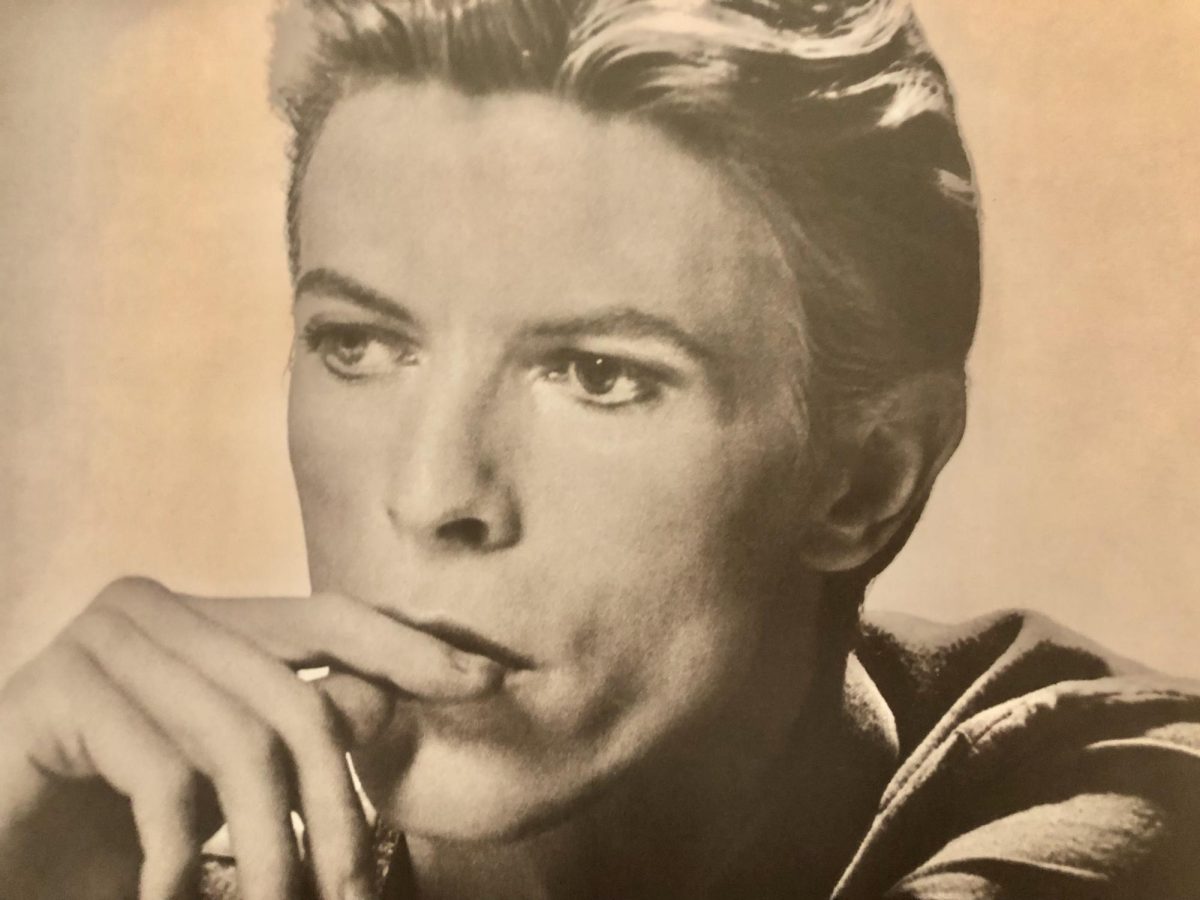Picture this: You are at a rock concert. But it is not just any rock concert. Before you is an epicene alien covered head to toe in glitter while being torn apart by his disciples from another planet. They are anitmatter beings, ripping pieces from his body and fusing them so that they are able to exist as beings on Earth. While watching this spectacle, the lyrics Oh no, love, you’re not alone / You’re watching yourself, but you’re too unfair / You got your head all tangled up / But if I could only make you care” blare in the background.
This slightly unhinged story is one crafted from the mind of David Bowie. It is the life, creation, and origin of Ziggy Stardust.
Bowie was a revolutionary rock artist in the late 60s and is still regarded as a titan of glam-rock— even after his death in 2016. Throughout his career, Bowie adapted a non-conventional approach to his fame. He created characters and adopted them to such an extreme that oftentimes he lost the ability to differentiate between reality and the fantasy in his mind. His most famous alter ego? Ziggy Stardust.
The concept of Ziggy Stardust is not the first of its kind. Bowie gathered inspiration from Iggy Pop, Vince Taylor, Kansai Yamamoto, and Lou Reed, among others.
Iggy Pop is believed to be the strongest reference that shines through in Ziggy Stardust. Pop’s deranged musical performance was a confirmed inspiration to Bowie, leading to speculation that the name “Ziggy” came partially from the name Iggy.
The inspiration from Reed goes hand in hand with Pop. After seeing Reed at a Velvet Underground concert, Bowie was both challenged and inspired. Reed channeled a “British view into an American street energy.” Bowie loved this style element and began to incorporate it into his music
Taylor, known as “The real life Ziggy Stardust,” was a British rock singer in the 50s and 60s. In the beginning of his career, he was known as Britain’s “Elvis Presley,” but the title was short-lived. As a child, Bowie would often run into Taylor, meaning he got a front row seat to Taylor’s declining sanity. Due to an overwhelming substance addiction, Taylor began to believe that he was the reincarnated Jesus Christ.
Bowie recalled Taylor once stopping him in the middle of the road to discuss his conspiracies: “One day, on Tottenham Court Road, he took out a map of the world and put it on the pavement. All these people were walking past us, and he was showing me where the aliens were keeping their arms and encampments.”
While Taylor may just be seen as a drug-addicted artist from the 60s, his conversations with Bowie were actually crucial to the foundation of Ziggy Stardust.
Kansai Yamamoto was the designer who brought Ziggy Stardust to life. His vivacious and feminine touch to his work, paired with Bowie’s desire for a gender ambiguous appearance to the character, crafted the perfect recipe of out-of-this-world yet undeniably recognizable.
The legendary album The Rise and Fall of Ziggy Stardust and the Spiders from Mars, was released on June 16, 1972, but it did not blow up until the band’s performance of the song “Starman” on July 6th. This historic performance was the turning point for the formation of a subculture of music lovers who could not get enough of this unique glam-rock genre. The album contains 11 songs, with many of these lyrics spelling out the story of Ziggy Stardust.
However, the actual character of Ziggy Stardust became so much more than an element of Bowie’s performance.
Bowie nearly embodied the alter-ego of Ziggy Stardust, arguably, to the point of reality distortion.
Ziggy was a fictional rockstar, who embodied an Alien messiah. His mission on earth was to save the dying planet from the downfall of rock ‘n roll. He arrives with an inflated ego and his band— The Spiders From Mars.
Bowie even adopted the name “The Spiders from Mars” as an official band name. The Spiders included Mick Ronson on guitar, Trevor Bolder on bass, and Mick Woodmansey on drums.
The song “Five Years” illustrates a decaying society, as Earth inhabitants learn that they only have five years left to live due to the decline in natural resources. As an alien (Ziggy Stardust) is coming to save the planet and set their souls free through rock music. Stardust struggles to remember as many things as he can about his surroundings.
I heard telephones, opera house, favourite melodies
I saw boys, toys electric irons and T.V.’s
My brain hurt like a warehouse
It had no room to spare
I had to cram so many things
To store everything in there
And all the fat-skinny people, and all the tall-short people
And all the nobody people, and all the somebody people
I never thought I’d need so many people
Bowie illustrates his observations with great metaphorical detail. He portrays the overwhelming experience of coming to Earth with the line “My brain hurt like a warehouse / It had no room to spare / I had to cram so many things /To store everything in there.” Later, we hear repetition of the line “My brain hurts a lot” as a scream in the background of the lyrics.
“Five Years” sets the scene prior to Ziggy’s takeover, but “Moonage Daydream” encapsulates the fantastic splendor of the musical chameleon.
I’m an alligator
I’m a mama-papa comin’ for you
I’m the space invader
I’ll be a rock ‘n’ rollin’ b**** for you
These lines represent the many forms that the eclectic alien could take. A big part of Ziggy’s character was gender ambiguity and spontaneous behaviors.
Ziggy recognizes himself as a prophet for the future aliens from his planet—The Starmen, who were extraterrestrial beings — and Bowie’s band members were the messengers.
One of Bowie’s most famous songs, “Starman,” is a message to the inhabitant of Earth. Reversing the common notion that aliens will come to Earth with the purpose of destroying it, Bowie wanted to create Ziggy Stardust to bring the younger generations hope. His goal for the Starmen was to enlighten younger generations.
Bowie and his team emerged from the 60s— an era of peace, love, rainbows, and groovy music. But Bowie did not jive with the era. He redefined the genre of glam-rock and encapsulated the energy of the decade’s anxieties in his music. He approached his expressions with a sense of both realism and empowerment for future generations.
Bowie’s most famous performance of “Starman” was on the British television program Top of the Pops. Not only did this performance send Bowie into stardom (no pun intended), it also introduced a new type of music to a new generation.
During the line “I had to phone someone so I picked on you,” Bowie makes eye contact with the camera and make a both encouraging and endearing gesture to the audience that almost puts a sense of responsibility to answer the call to make change.
However, the album is called The Rise and Fall of Ziggy Stardust. Unfortunately, like many famous rock stars, Ziggy had a tragic downfall. He was plagued by the ego that only fame can inspire. Indulging in self-aggrandizement, the character built him up to the point of destruction. In the song “Ziggy Stardust,” the following lines illustrate both the hold his supercilious view had on himself and the way it changed his band members’ perceptions of him.
He took it all too far
But boy, could he play guitar
Making love with his ego
Ziggy sucked up into his mind, ah
Like a leper messiah
When the kids had killed the man
I had to break up the band
As well as enveloping the damage his ego was causing, the lyrics also foreshadow the events that take place in the song “Rock ‘n’ Roll Suicide” — the final death of Ziggy Stardust.
The number is a beautiful ballad that brings awareness to the risks inherent in the culture of rock ‘n roll. Drug abuse, lack of rest, and the temptations of fame have taken the lives of many artists. They seal Ziggy’s fate as well.
“Time takes a cigarette, puts it in your mouth” is surely a nod to both the toll that time and Bowie’s drug dependency took on Stardust.
“You’re too old to lose it, too young to choose it
And the clock waits so patiently on your song”
Ziggy’s story comes to a close as he performs his final ballad while being torn to shreds by the Starmen who, in turn, become a physical manifestation of a rock star.
Perhaps the decline of Ziggy Stardust was inevitable. One cannot build such a character and attract such a following to the point of prophesying and still maintaining sustainable sanity.
On July 3, 1973 at the London Hammersmith Odeon Theater, Bowie abruptly announced his last show as Ziggy Stardust and The Spiders from Mars. Ziggy and Bowie had become synonymous, and Bowie felt that, while Ziggy would forever be a part of him, he was washed up. It was time for Aladdin Sane.




howard lauderback • Mar 26, 2024 at 6:56 pm
Truly the greatest rock star ever. Saw him live 9 times, miss him much.
Scott Ewing • Nov 5, 2023 at 1:11 pm
That was my first LP and my favorite. There isn’t a bad song on the entire album. David Bowie is and was a musical genius. Long live Rock and Roll it’ll never die!!
Ava DiGiacomo • Nov 7, 2023 at 7:14 pm
It is truly a phenomenal and revolutionary piece of art!!